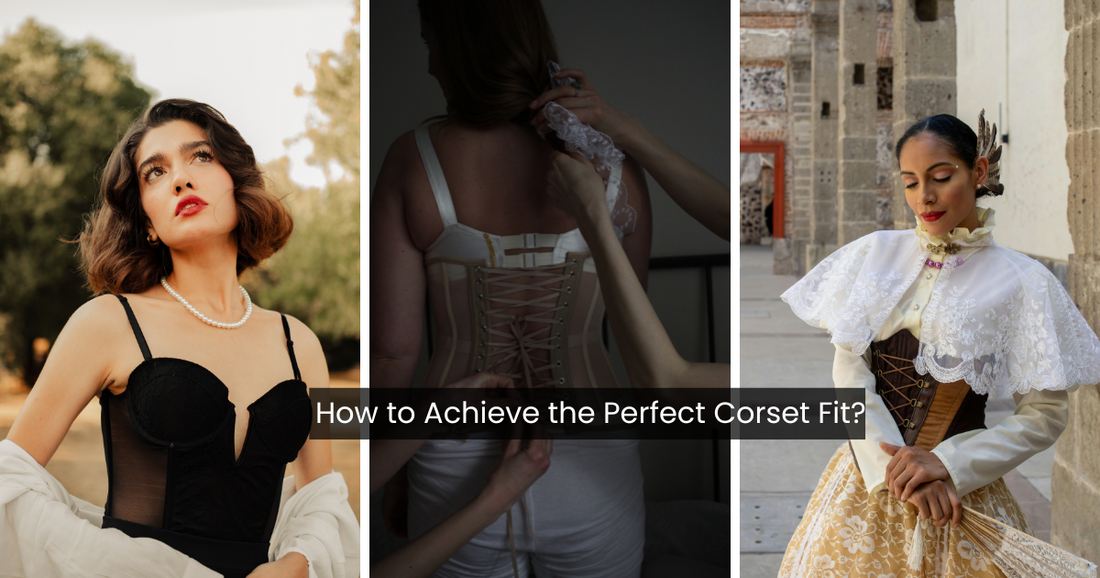
How to Achieve the Perfect Corset Fit: The Complete Guide
Share
Perfect Corset Fit: To find your corset size, if your natural waist is 26 inches, and your full bust is 34 inches, you should look for a corset in the 20-22 inch range. This is because you subtract 4-6 inches from your waist measurement. If your hip measurement is 36 inches, make sure the corset fits comfortably around your hips too. Always check the brand's sizing chart, as sizes can be different.
Wearing a corset can change how you look and feel. A well-fitting corset can give you a beautiful shape and boost your confidence. This guide will help you understand how to find the perfect fit for your corset. We will talk about everything, from measuring your body to trying on the corset and adjusting it.
Let’s get started!
What is a Corset?
A corset is a supportive garment that shapes the body and improves posture. It is made from strong fabric and features stiff pieces called boning, which can be plastic or steel. Corsets have a front part known as a busk and laces for tightening or loosening. They were popular in Europe from the 17th to the early 20th century. Initially, corsets helped keep clothing smooth and created attractive silhouettes.
They made the waist look smaller and enhanced the bust and hips. Over time, their design evolved from a straight shape in the Tudor period to the curvy hourglass style of the 19th century. Today, corsets are used not only in fashion but also for medical support and in alternative styles.
Their cultural significance and unique aesthetic continue to attract interest. This makes them a timeless piece of clothing. By understanding the history and uses of corsets, you can appreciate their role in fashion and body shaping throughout the years.

Types of Corsets
Corsets come in various lengths and styles, each designed to provide different levels of support and shaping. Understanding these types can help you choose the perfect fit for your needs.
Underbust Corset
The underbust corset sits just below the bust and extends down to the waist. This design supports the waist and hips while leaving the bust area open. It's perfect for layering under your favorite outfits or even wearing as a stylish outerwear piece. This type is great for those who want to emphasize their waist without compressing the bust.
Overbust Corset
An overbust corset covers the bust and extends down to the hips, offering comprehensive support and shaping for the bust, waist, and hips. This corset is often worn as fashionable outerwear or elegant lingerie. It’s an excellent choice for those seeking a more defined hourglass figure, as it helps lift and shape the bust while cinching the waist.
Mid-Bust Corset
The mid-bust corset starts at the middle of the bust, providing support without overly pushing up the breasts. This style offers a streamlined silhouette, making it a popular choice for those who want a comfortable fit that still enhances their natural shape. It’s versatile enough to be worn under clothing or as a standalone piece.
Waspie
A waspie is a shorter style of corset that focuses specifically on tightening the waist. Typically ending just above the hips, it’s designed to create an exaggerated waistline, making it ideal for pairing with high-waisted skirts or pants. This type is perfect for those looking to accentuate their waist without the full coverage of a longer corset.
Longline Corset
The longline corset extends over the bust and down to the hips, providing a longer silhouette that beautifully accentuates curves. This style is especially popular for special occasions, as it offers a smooth, elongated look. The longline design can help create a stunning hourglass figure, making it a favorite for formal wear and costume styles.
Waist Cinchers
In addition to corsets, waist cinchers are also popular for waist training and shaping. These are typically shorter than traditional corsets and are designed to fit snugly around the waist. Waist cinchers can be worn discreetly under clothing or as part of an outfit. They are excellent for those looking to achieve a more defined waist without the structure of a full corset.
Corset Belts
Corset belts are a modern twist that combines the elements of traditional corsets with the practicality of a belt. These belts are typically worn around the waist and can be adjusted for a snug fit. They add a stylish flair to outfits, accentuating the waist while providing a unique look. Corset belts can be worn over dresses, blouses, or even jackets, making them a versatile accessory for any wardrobe.
By understanding the different lengths and styles of corsets, waist cinchers, and corset belts, you can find the right option to suit your style and needs, whether for everyday wear or special occasions
How to Measure Your Body for a Corset

Measuring your body accurately is the first step to finding the right corset size. A well-fitted corset can enhance your silhouette and ensure comfort. Follow these simple steps to measure yourself correctly for a corset.
Tools You’ll Need to measure corset
- 1. Soft Measuring Tape: A flexible tape is essential for accurate measurements.
- 2. Mirror: A full-length mirror will help you see your body clearly.
- 3. Pen and Paper: To write down your measurements for future reference.
Step-by-Step Measuring Guide For Corset
1. Measure Your Waist
- Find Your Natural Waist: Stand up straight and bend to one side. The point where your body naturally bends is your waist.
- Take the Measurement: Wrap the measuring tape around your waist at this point. Ensure the tape is snug but not too tight. You should be able to breathe comfortably. Make a note of this measurement.
2. Measure Your Bust
- Locate the Fullest Part of Your Bust: Stand naturally and find the fullest part of your bust. This is usually around the nipples.
- Take the Measurement: Wrap the measuring tape around your bust, keeping it level across your back. Make sure the tape is straight and not too tight. Write down this measurement.
3. Measure Your Hips
- Find the Widest Part of Your Hips: Stand with your feet together and find the widest part of your hips, which is usually around 8 inches below your waist.
- Take the Measurement: Wrap the measuring tape around this area, ensuring it is even and snug but not tight. Record this measurement.
4. Measure Your Torso Length
- Determine Your Torso Length: This measurement will help you know how long your corset should be.
- Take the Measurement: Measure from the top of your bust down to your natural waist. This will give you the torso length. Note this measurement as well.
It’s always a good idea to measure twice to ensure accuracy. Go through each step again and confirm that your numbers are consistent.
Write Down Your Measurements
Once you have all your measurements, write them down clearly. You should have:
- Waist: 28 inches
- Bust: 36 inches
- Hips: 38 inches
- Torso Length: 14 inches
To find your corset size, if your natural waist is 26 inches, and your full bust is 34 inches, you should look for a corset in the 20-22 inch range. This is because you subtract 4-6 inches from your waist measurement. If your hip measurement is 36 inches, make sure the corset fits comfortably around your hips too. Always check the brand's sizing chart, as sizes can be different.
Tips for Accurate Measurements

- Wear Fitted Clothing: Wear a fitted top and bottom or just your underwear while measuring. This way, the tape can lay flat against your body.
- Stand Up Straight: Good posture helps ensure accurate measurements. Stand straight but relaxed.
- Get Help If Needed: If you find it difficult to measure certain areas, ask a friend for assistance. They can help ensure the tape is straight and even.
Taking accurate body measurements is crucial for finding the right corset size. By following these steps, you can ensure a comfortable and flattering fit. Once you have your measurements, you can confidently shop for a corset that suits your body shape and style. Remember to keep your measurements handy for future reference, as your body may change over time.
Choosing the Right Size Of Corset
Now that you have your measurements, you can choose the right corset size.
Look at the size chart provided by the Lara Leather. Compare your waist measurement to the chart. Corsets are meant to be tight, so you might choose a size smaller than your natural waist measurement for a snug fit.
Ensure that the corset fits your bust and hips well. A corset that fits your waist but is too tight on your bust or hips will not be comfortable.
Understanding Corset Construction
Knowing how a corset is made will help you understand how to get the right fit.
Boning: Boning is the material inside the corset that gives it structure. It can be made from plastic or steel. Steel boning is stronger and provides better support, while plastic boning is more flexible and can be more comfortable.
Busk Closure: Most corsets have a busk closure at the front. This usually consists of hooks and loops that you can adjust to tighten the corset. Make sure the busk is secure but not too tight when you fasten it.
Lacing: Corsets have laces at the back that help you tighten the fit. Make sure the laces are even on both sides. This ensures a balanced and comfortable fit.
Breaking in Your Corset

New corsets can feel stiff and uncomfortable at first. You need to break them in gradually. Here’s how to do it:
Wear It for Short Periods: Start by wearing the corset for short periods, around 30 minutes to an hour. Gradually increase the time you wear it each day. This will help the fabric relax and mold to your body shape.
Listen to Your Body: If you feel any pain or discomfort, loosen the laces or take off the corset. It is important to feel comfortable while wearing it.
Keep It Clean: Take care of your corset by keeping it clean. Follow the care instructions from the manufacturer. Usually, you can wipe down the fabric with a damp cloth and let it air dry.
Tips for Maintaining the Perfect Fit
After achieving the perfect fit, maintaining it is essential. Here are some tips to help:
Regularly Check Your Measurements
Your body can change over time. It is good to check your measurements regularly, especially if you have lost or gained weight.
Store Your Corset Properly
When you are not wearing your corset, store it correctly. Hang it up to keep its shape, or lay it flat. Avoid folding it, as this can damage the boning.
Wear It with Confidence
Once you have the perfect fit, wear your corset with pride! Whether dressing up for a special occasion or adding flair to your everyday outfit, a well-fitting corset can enhance your look and boost your confidence.
Final Words: Finding the perfect corset fit
Finding the perfect corset fit takes time and patience, but it is worth it. With the right measurements, size, and adjustments, you can enjoy the benefits of a beautifully fitting corset. Remember to take your time, listen to your body, and seek help if you need it.
Now that you have this complete guide, you are ready to find your perfect corset. Enjoy trying different styles and find the corset that makes you feel great! If you have any questions or need more advice, feel free to ask.


